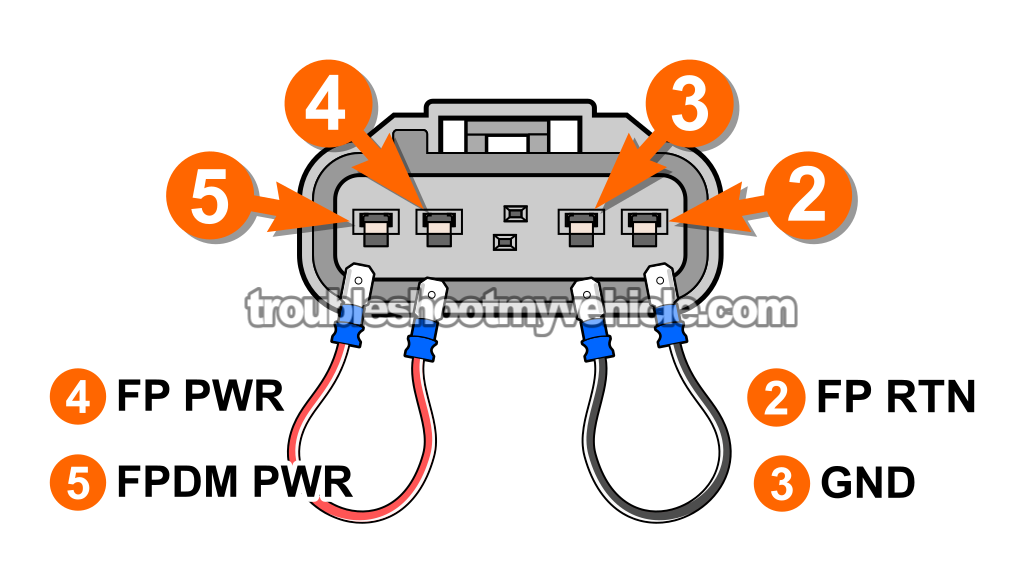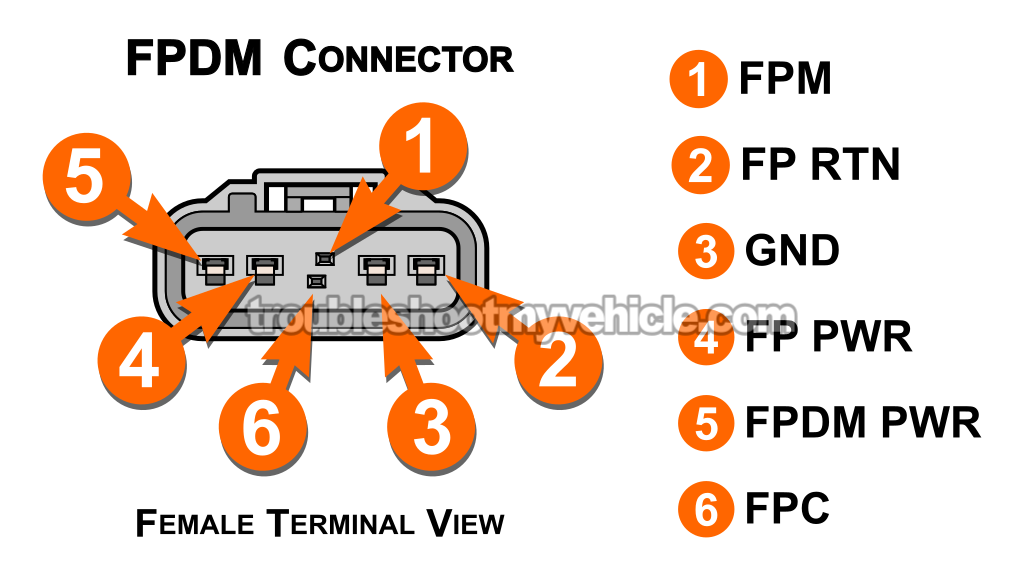
Bypassing the fuel pump driver module (FPDM), on the 2004-2010 4.0L V6 Ford Explorer (or Mercury Mountaineer) is a fast and easy way to manually power the fuel pump and find out if it's still runs.
This test especially comes in handy when you're dealing with an engine no-start and suspect the fuel pump, since it'll help you confirm whether it's working or not.
In this tutorial, I'll show you how to build custom jumper wires and walk you through the bypass procedure step-by-step.
I'll also point you to a complete guide on how to test the FPDM itself, in case you need to dig a little deeper into the issue.
Contents of this tutorial:
APPLIES TO: This tutorial applies to the following vehicles:
- 4.0L V6 Ford Explorer: 2004, 2005, 2006, 2007, 2008, 2009, 2010.
- 4.0L V6 Mercury Mountaineer: 2004, 2005, 2006, 2007, 2008, 2009, 2010.
MORE FUEL PUMP DIAGNOSTIC RESOURCES: You can find fuel pump circuit wiring diagrams, related fuel pump tests, and the inertia switch tests in this section:
How To Make The Jumper Wires
To safely bypass the FPDM, you're gonna need a pair of custom-made jumper wires. These jumper wires will use standard blue male spade crimp connectors.
The one thing we need to keep in mind is that the male spades on some of these connectors are wider or thicker than the actual FPDM male terminals, which can damage the female terminals inside the FPDM's 6-wire connector.
So before we jam anything into the connector's terminals, we need to take a close look at the size and thickness of the blue crimp connector's male spade terminal. If the male spade terminal is too thick and/or too wide:
- Trim the width using a wire cutter to match the FPDM terminal shape.
- Sand down the thickness using a file or sandpaper until the spade slides in smoothly, just like the original FPDM terminal would.
The goal here is simple: a snug, non-destructive fit. Anything too tight can spread the female terminals and create intermittent or false connections later —and that's a diagnostic nightmare you want to avoid.
Match the wire gauge. Whatever two wires you're jumpering, the wire you use must be the same thickness (gauge). Don't go smaller. Use automotive-grade wire and after crimping your connectors to the wire, make sure it's a solid crimp.
One last thing: You don't need to add an inline fuse to your jumper wire. Why? Because we're not introducing power from an external source —we're simply connecting two factory-circuited wires. The power circuit is already protected by the fuel pump relay fuse. So even though our jumper doesn't have a fuse, the entire circuit is still protected.
Alright, before we move on, I want to just say: take your time making the jumper wires —it makes all the difference between a clean, reliable bypass and a hacked-together mess that might haunt you later.
Fuel Pump Driver Module Bypass Essentials
Before we get into the actual bypass steps, let's talk about what bypassing the FPDM does —and what it doesn't do.
Bypassing the fuel pump driver module is only useful for checking the condition of the fuel pump itself. In other words, if the fuel pump turns on during the bypass, all we've confirmed is that the pump can run. That's it.
It doesn't confirm whether the FPDM is good or bad —only that power is reaching the pump through the bypass. And maybe that's all we need to know, that the fuel pump is turning on (or not turning on).
Now the cool part is this: testing the FPDM itself is actually very simple. You just need a multimeter that can read duty cycle %. These meters are affordable, and I've written a full tutorial that walks you through the entire FPDM test step by step —you can check it out here:
Now, I'm not saying this to discourage you from performing the bypass. Far from it. Bypassing the module can help you quickly check the pump's operation, and I'll show you exactly how to do it safely and cleanly.
But here's a pro tip: to get the most accurate test result, hook up a fuel pressure gauge to the fuel rail while you perform the bypass. That way, you're not just listening for a humming pump —you're actually seeing if the pump can produce the specified pressure the system needs.
It's not uncommon to hear the pump running inside the tank... But if it's weak and not building pressure, you're back to square one —still not knowing if the pump is healthy or toast. This tutorial explains how to connect a fuel pressure test gauge:
How To Bypass The FPDM Step-By-Step
These are the test steps:
- Make sure the key is in the OFF position or is removed from the ignition switch.
- Unplug the FPDM connector.
- Jumper female terminals 4 and 5. This is the fuel pump's power circuit side.
- Terminal 4 connects to the fuel pump's (+) terminal.
- Terminal 5 has 12 Volts only with the key in the RUN or START position. This voltage comes from the fuel pump relay via the inertia switch.
- Jumper female terminals 2 and 3. This is the fuel pump's Ground circuit side.
- Terminal 2: This terminal connects to the fuel pump's (-) terminal.
- Terminal 3: This terminal connects to chassis Ground.
- Turn the key to the RUN or START position.
- The fuel pump should come on. You might hear a hum or buzz from the tank area.
- Your fuel pressure gauge should indicate around 60 to 65 PSI.
What the results tell you:
- Pump runs and fuel pressure is at specification: The pump is good.
- Pump runs but fuel pressure is below specification: The pump is failing.
- Pump doesn't run and/or fuel pressure is at 0 PSI: The pump is bad.
Keep in mind, that this FPDM bypass test only checks the condition of the fuel pump itself, and not the FPDM module. If you do need to test the module (and it's a super easy test to do), I've written a tutorial that'll help you do that:
More Fuel Pump Troubleshooting Help
FUEL PUMP PRESSURE TESTS:
FUEL PUMP DRIVER MODULE (FPDM) TESTS:
- FPDM Basic Operating Theory (2004-2010 4.0L V6 Ford Explorer And Mountaineer).
- Fuel Pump Driver Module Tests (2004-2010 4.0L V6 Ford Explorer And Mercury Mountaineer).
- Bypassing The FPDM Module (2004-2010 4.0L V6 Ford Explorer And Mercury Mountaineer).
FUEL PUMP AMPERAGE DRAW TEST:
FUEL PUMP INERTIA SWITCH TESTS:
- Fuel Pump Inertia Switch Tests (1991-2010 4.0L V6 Ford Explorer, Aerostar, And Mercury Mountaineer).
- Power To Fuel Pump Check (1991-2010 4.0L V6 Ford Explorer, Aerostar, And Mercury Mountaineer).
ENGINE NO-START DIAGNOSTICS:
FUEL PUMP CIRCUIT DIAGRAMS:
- Fuel Pump Circuit Wiring Diagram (2004 4.0L V6 Ford Explorer And Mercury Mountaineer).
- Fuel Pump Circuit Wiring Diagram (2005 4.0L V6 Ford Explorer And Mercury Mountaineer).
- Fuel Pump Circuit Wiring Diagram (2006-2010 4.0L V6 Ford Explorer And Mercury Mountaineer).
More 4.0L V6 Ford Explorer And Mercury Mountaineer Tutorials
I have written several more 4.0L V6 Explorer/Mountaineer specific test articles. You can find them all here:
The following tutorials are a sample of the articles you'll find in the index:
- How To Test The CKP Sensor (1997-2010 4.0L V6 Ford Explorer And Mercury Mountaineer).
- Fuel Pressure Specifications (1991-2010 4.0L V6 Ford Explorer, Mercury Mountaineer).
- How To Test For A Blown Head Gasket (1991-2010 4.0L V6 Ford Explorer, Aerostar, And Mercury Mountaineer).
- Troubleshooting P0171 And P0174 (1996-2003 4.0L V6 Ford Explorer, Aerostar, And Mercury Mountaineer).

If this info saved the day, buy me a beer!



